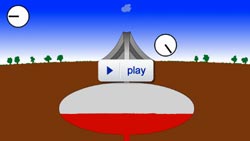Monitoring volcanoes with ground-based atomic clocks

The video shows, how atomic clocks can be used to monitor volcanoes. (Source: UZH)
Atomic clocks measure time with unbelievable accuracy. The best atomic clocks are so precise that they would lose less than one second over a period of 10 billion years. However, they are generally only used in laboratories.
Science and industry have yet to take full advantage of their unprecedented ability to measure time. An international team including Dr. Ruxandra Bondarescu, Andreas Schärer and Prof. Philippe Jetzer from the Institute of Physics from the University of Zurich discusses potential applications for atomic clocks.
Their analysis shows that the slow down of time predicted by general relativity can be measured by local clocks and used to monitor volcanoes. General relativity states that clocks positioned at different distances from a massive body like the Earth have different tick rates. The closer a clock is to a massive object, the slower it ticks.
In a similar manner, subterranean objects influence the tick rate of local clocks that are located above the Earth’s surface. New lava filling a magma chamber beneath a volcano makes a clock located above that volcano tick more slowly than a clock that is located further away. Volcanoes are currently monitored using GPS receivers.
The resulting data often has to be integrated over a period of several years before an estimate of the volume of new magma can be made. A network of local, highly precise atomic clocks may provide the same information within a few hours. This would make it possible to monitor processes inside volcanoes more closely and to make better predictions for future volcanic eruptions.
Monitoring the solid Earth tides with a global network of atomic clocks
Atomic clocks can also be used to monitor the solid Earth tides. Tides occur because the Earth moves in the gravitational field of the Sun and the Moon. It reacts to this outer field by deforming, which in turn leads to ocean tides and to the ground on the continents lifting and falling regularly. The ground can rise as much as 50 cm. A global network of atomic clocks that are connected via fiber optic cables used for internet, could provide continuous measurements of the Earth tides and check existing theoretical models. It would also be possible to examine any local differences in the response of the Earth’s crust to the Earth tides.
The researchers hope that high precision clocks could be deployed in volcanic areas in the next few years. This is, however, subject to sufficient interest and investment from industry. “We need this additional tool to monitor magma movement under volcanoes such as the Yellowstone supervolcano, which is overdue for an explosion that would alter life on Earth as we known it”, explains Bondarescu.
Literature:
Ruxandra Bondarescu, Andreas Schärer, Andrew P. Lundgren, György Hetényi, Nicolas Houlié, Philippe Jetzer, and Mihai Bondarescu. Atomic Clocks as a Tool to Monitor Vertical Surface Motion. Express letter in the Geophysical Journal International, in Press. arXiv:1506.02457.
Contacts:
Dr. Ruxandra Bondarescu
Physik-Institut
University of Zurich
Tel.: +41 44 635 58 04
Email: ruxandra@physik.uzh.ch
Prof. Philippe Jetzer
Physik-Institut
University of Zurich
Tel.: +41 44 635 58 19
Email: jetzer@physik.uzh.ch
Media Contact
All latest news from the category: Earth Sciences
Earth Sciences (also referred to as Geosciences), which deals with basic issues surrounding our planet, plays a vital role in the area of energy and raw materials supply.
Earth Sciences comprises subjects such as geology, geography, geological informatics, paleontology, mineralogy, petrography, crystallography, geophysics, geodesy, glaciology, cartography, photogrammetry, meteorology and seismology, early-warning systems, earthquake research and polar research.
Newest articles

NASA: Mystery of life’s handedness deepens
The mystery of why life uses molecules with specific orientations has deepened with a NASA-funded discovery that RNA — a key molecule thought to have potentially held the instructions for…

What are the effects of historic lithium mining on water quality?
Study reveals low levels of common contaminants but high levels of other elements in waters associated with an abandoned lithium mine. Lithium ore and mining waste from a historic lithium…

Quantum-inspired design boosts efficiency of heat-to-electricity conversion
Rice engineers take unconventional route to improving thermophotovoltaic systems. Researchers at Rice University have found a new way to improve a key element of thermophotovoltaic (TPV) systems, which convert heat…



